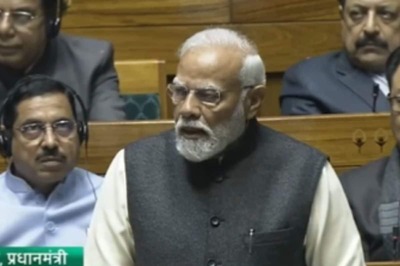
views
Global headwinds continue to pose a downside risk to India’s economic growth as crude oil and edible oils, which have driven inflation in India, remain the major imported components in the consumption basket. Currently, however, their global prices have softened, as fears of recession have dampened prices somewhat, the finance ministry said on Thursday.
“Recent moderation in the international prices of food items, industrial metals and even crude oil are welcome developments for India’s inflation control. Recent revenue generation measures announced by the government will not only help to rein in the rise in the current account deficit but also ensure that fiscal slippage, if any, is well contained,” the ministry said in a report, Monthly Economy Review for June.
It said the depreciation in rupee, in addition to elevated global commodity prices, has also made price-inelastic imports costlier, thereby making it further difficult to reduce the CAD (current account deficit). To meet the financing needs of a widening CAD and rising FPI outflows, forex reserves, in the six months since January 2022, have declined by $34 billion.
“The widening of CAD has depreciated the Indian rupee against the US dollar by 6 per cent since January of 2022. The rupee has performed well in 2022 compared to other major economies unlike in 2013, where it depreciated against other major economies, thus, reflecting the strong fundamentals of the Indian economy,” the ministry said.
The report added that global trade slowed in Q1 2022-23 as compared to Q4 2021-22 largely affected by disruption in supply chains, broad-based inflationary pressures, increased uncertainty and the resulting slowdown in global growth, leading to a moderation in India’s exports in the current quarter (Q1 2022-23) compared to the previous quarter (Q4 2021-22).
Shortages, unprecedented commodity price rises, and rising US dollar induced by monetary tightening have meant a rising import bill for net import-dependent countries like India. Consequently, on account of a faster rise in imports than exports, the trade deficit widened in Q1 2022-23 from the previous quarter, it said.
The report also said, “Economic activity is holding up better than expected despite the ongoing geopolitical tensions; rise in interest rates in America and in India and the elevated price of crude oil and few other commodities. The services sector recovery is continuing and manufacturing strength is steady. There is an apparent keenness to invest on the part of the private sector. Banks are willing to lend and their financial health, as the central bank’s stress tests reveal, is quite strong. Brisk GST receipts monthly confirm the momentum in the economic activity.”
It said that at the margin, June and the first 10 days of July were better for Indian macro than the first two months of the current financial year. “That is some cause for relief and even cautious optimism in these times.”
Read all the Latest News, Breaking News, watch Top Videos and Live TV here.

















Comments
0 comment